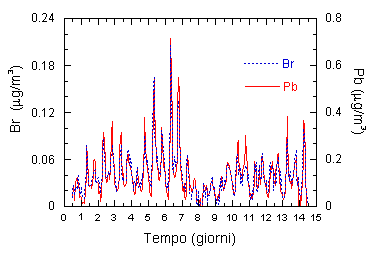Sezione di Genova
Università di Genova
|
|
ISTITUTO NAZIONALE DI FISICA NUCLEARE
Sezione di Genova |
DIPARTMENTO DI FISICA
Università di Genova |
|
Environment
IBA techniques and mainly PIXE, are a powerful tool to investigate environmental problems: they are indeed particularily suitable for the study of atmospheric paticulate. Fine particulate spread in atmosphere by exhauste gases of cars, industrial processes, biomass combustion and by many other processes have been studied in detail in the last years. Their effects become more and more serious and public is more concerned about problems like the pollution in large inhabited areas or the climatic changes on planetary scale.
The chemical composition and the size of the particulate may change as a function of their origin, of the transformations undergone in the atmosphere, and of the mechanisms of removal and transport. Finally the particulate is made by clusters of molecules with size ranging from a few nm (1 nm = 10-9 m = 1 millionth of millimeter) up to about 100 mm (1 mm = 10-6 m = 1 thousandth of millimeter). In figure 2 is shown an ideal size distribution of the atmospheric particulate.

Harmful effects of the atmospheric particulate obviously depend on the chemical composition (some substances are expecially toxic) but also on the granulometry: in fact only the thinnest particles can penetrate into the breathing apparatus (see figure 3)and to produce the worst damages.
Also the environmental effects (visibility reduction, diffusion of the solar radiation, generation of fog) strongly depend on the size of the particles. A complete discussion of these phenomena is given in: “Atmospheric Chemistry and Physics of Air Pollution”, J. H. Seinfeld, Wiley ed., New York 1986. Atmospheric particulate can be collected, for further laboratory analysis, with different samplers. Samplers can be filters or impactors (according to the used technique) and can be distingushed between continuous or cumulative (according to the timing of the sampling procedure). In some cases instrumentation is able to separate the different dimensional fractions on separate layers (multistages). Our Laboratory is equipped with several instruments: sequential sampler partisol, sampler Battelle with 7 stages, continuous sampler streaker.
Used filters are porous layers, usually policarbonate membranes(NUCLEPORE), cellulose acetate (MILLIPORE) or Teflon (CF2).(figure 5)
PIXE analysis of the samples of atmospheric particulate usually provides the concentrations (in atmosphere) of about twenty elements with a minumum detection limit ranging between 1 and 10 ng/m3. Figure 6 shows a typical PIXE spectrum of elements with atomic number Z>20, obtained irradiating a TPS sample collected near an industrial site in Genova district

The concentration of different elements in the atmosphere can be separated according to the different granulometirc fractions can be carried on, as reported in figura 7, where are shown the results obtained in a simultaneous sampling campaign in the italian cities of Firenze, Genova, Milano and Napoli during the 2001 winter.
The use of continuous samplers, such as the "streakers", allows a study of the time profile, typical of several elements and/or particulate sources. Some examples are shown in the graphics of figures 8a,8b and 8c, relative to measurement campaigns in Liguria between 1995 and 2000.

Finally multistage samplers allow to reconstruct and to differentiate granulometric distributions of each element, as shown in figure 9.

FISA Laboratory is also equipped with an instrumentation able to measure in real time the total concentration of particles in the PM10 or PM2.5 or PM1 fractions: this is TEOM (Tapered Element Oscillating Microbalance) figure 10, with a sensitivity of 60 ng/m3 for the measurement of the hourly concentration of the atmospheric particulate.
Ths instrument has been installed in the monitoring station of their quality of air at Genova-Brignole in july 2001: since that time it continuously records concentrations and time profiles for the different size fractions of the atmospheric particulate. As an example, in figure 11 are reported the data recorded during the G8 summit period in Genova (July 2001). A clear reduction of powders can be seen during the period of nearly total traffic-block in the center of town.

Light elements, that is those who emit X radiation with energy lower than 1 keV,
cannot be detected by PIXE due to the strong X-rays attenuation
(m/r>7000 g/cm3)
along the sample-detector path. Among them Carbon plays a major role, both for its
sizeable concentration in the atmospheric particulate, and for the high absorption
of visible light. FISA developed a simple optical method
(figure 12) to measure the attenuation of a laser beam
passing through the particulate samples: it allows to evaluate (even if with high
systematic uncertainties) the elemental carbon concentration (or black carbon) in the
particulate.
This system is particularily useful and fast for the analysis of filters from
the streaker sampler: in figure 13 is shown the correlation between the optical
measurement and the time profile of some gaseous pollution typical of the
road traffic.

FISA Activities in the environmental sector have been developed in collaboration
with the research group of Florence University
and, more recently, with the group of
Milan University.
During the last years several campaigns have been carried on
in several sites of Genova (suburbs of Multedo, Acquasola, Albaro,
Cornigliano, Sestri Ponente, Brignole), of Firenze (Via Gramsci, Giardini di Boboli),
La Spezia, Milano, Napoli, Montelupo (FI) and Cogoleto (GE).
The same techniques have been applied by other researchers in Berlin, Madrid and
Seville. All the campaigns have been carried on in collaboration with the Local
Authorities responsible for the control on the air quality.
A complete report on the developed and applied methodologies can be deduced from the
publications list reported in this web site.
FISA today owns a series of instruments allowing a
wide veriety of measurements and investigations (illustrated in the previous figures)
on the atmospheric particulate:
Samplers:
Other:
|
|
HOME |